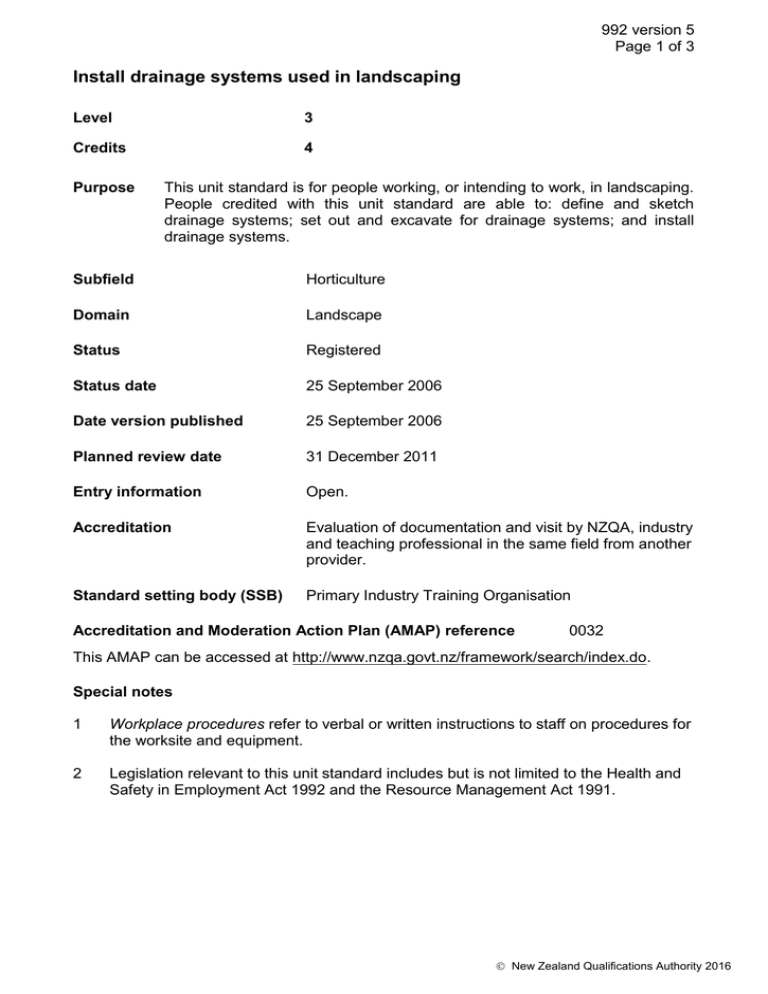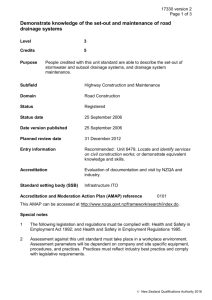Install drainage systems used in landscaping
advertisement

992 version 5 Page 1 of 3 Install drainage systems used in landscaping Level 3 Credits 4 Purpose This unit standard is for people working, or intending to work, in landscaping. People credited with this unit standard are able to: define and sketch drainage systems; set out and excavate for drainage systems; and install drainage systems. Subfield Horticulture Domain Landscape Status Registered Status date 25 September 2006 Date version published 25 September 2006 Planned review date 31 December 2011 Entry information Open. Accreditation Evaluation of documentation and visit by NZQA, industry and teaching professional in the same field from another provider. Standard setting body (SSB) Primary Industry Training Organisation Accreditation and Moderation Action Plan (AMAP) reference 0032 This AMAP can be accessed at http://www.nzqa.govt.nz/framework/search/index.do. Special notes 1 Workplace procedures refer to verbal or written instructions to staff on procedures for the worksite and equipment. 2 Legislation relevant to this unit standard includes but is not limited to the Health and Safety in Employment Act 1992 and the Resource Management Act 1991. New Zealand Qualifications Authority 2016 992 version 5 Page 2 of 3 Elements and performance criteria Element 1 Define and sketch drainage systems. Performance criteria 1.1 Situations where drainage systems are required in landscaping are defined in terms of the characteristics of those situations. Range low lying and catchment areas, sub-soil pans, high water tables, high retention soils. 1.2 Surface and sub-surface drainage systems are described in terms of their functions. 1.3 Collection points in drainage systems are described in terms of their functions. 1.4 Cross sections of drainage system elements are sketched and labelled to show construction. Range one example of each of – surface drains, sub-surface drains, collection points. Element 2 Set out and excavate for drainage systems. Performance criteria 2.1 Drainage system elements are set out in accordance with drawings and/or site requirements using measuring and levelling equipment. Range 2.2 elements – collection points, drainage runs, discharge points. Excavations for drainage elements are made to line, depth, and grade using hand tools and light mechanical equipment in accordance with workplace procedures. Element 3 Install drainage systems. Performance criteria 3.1 Surface drainage elements are installed to specification and manufacturer's instructions. Range one of – concrete channel, preformed concrete or clay units, proprietary plastic units. New Zealand Qualifications Authority 2016 992 version 5 Page 3 of 3 3.2 Sub-surface drainage elements are installed to specification and manufacturer’s instructions. Range 3.3 Collection points are installed to specification and manufacturer's instructions for preformed units. Range 3.4 Local Authority requirements, Resource Management Act 1991. Backfill and compaction are completed in accordance with workplace procedures, without damage to drainage elements, and minimising risk of subsidence of fill. Range 3.6 cast in situ or preformed; entry and exit connections, surface drainage and access covers. Discharge points and connections established meet regulatory requirements. Range 3.5 elements may include but are not limited to – plastic piping, perforated plastic piping, preformed clay units, drainage metal, filter cloths. completion – design features, special characteristics, documentation. The site is left in a condition that enables further work to proceed unimpeded in accordance with workplace procedures. Please note Providers must be accredited by the Qualifications Authority, or an inter-institutional body with delegated authority for quality assurance, before they can report credits from assessment against unit standards or deliver courses of study leading to that assessment. Industry Training Organisations must be accredited by the Qualifications Authority before they can register credits from assessment against unit standards. Accredited providers and Industry Training Organisations assessing against unit standards must engage with the moderation system that applies to those standards. Accreditation requirements and an outline of the moderation system that applies to this standard are outlined in the Accreditation and Moderation Action Plan (AMAP). The AMAP also includes useful information about special requirements for organisations wishing to develop education and training programmes, such as minimum qualifications for tutors and assessors, and special resource requirements. Comments on this unit standard Please contact the Primary Industry Training Organisation www.primaryito.ac.nz if you wish to suggest changes to the content of this unit standard. New Zealand Qualifications Authority 2016





